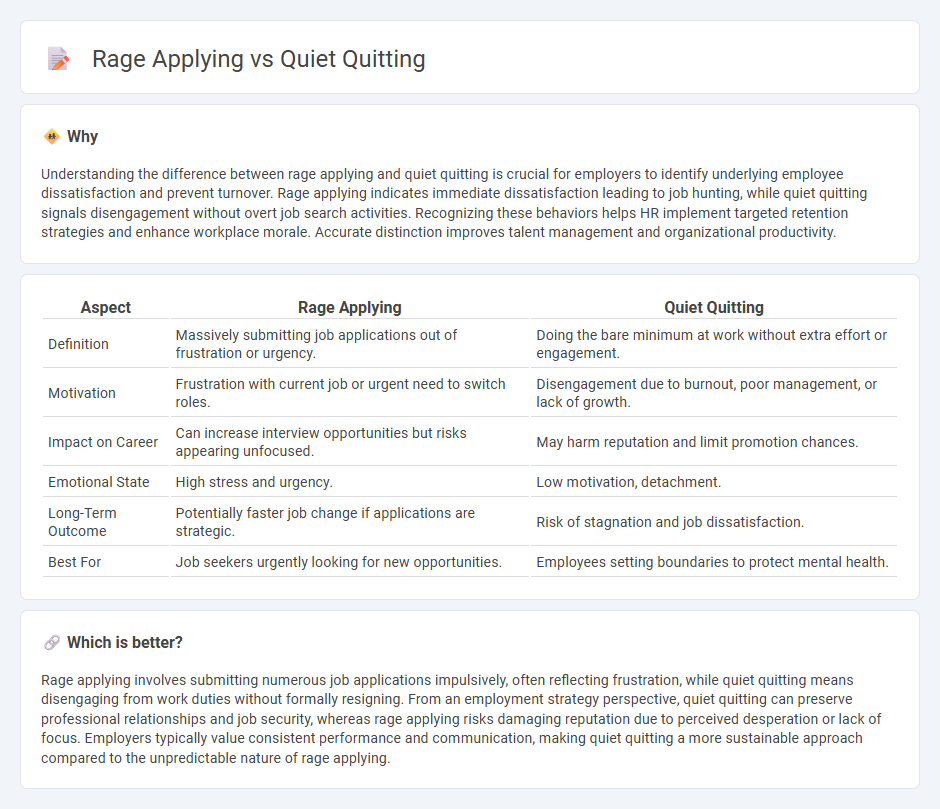
Rage applying involves submitting multiple job applications out of frustration with current employment, often reflecting urgency to leave a dissatisfying role. Quiet quitting means employees limit their work effort to their job description without engaging beyond it, signaling disengagement without outright resignation. Explore these contrasting workplace behaviors to understand their impact on career trajectories and organizational dynamics.
Why it is important
Understanding the difference between rage applying and quiet quitting is crucial for employers to identify underlying employee dissatisfaction and prevent turnover. Rage applying indicates immediate dissatisfaction leading to job hunting, while quiet quitting signals disengagement without overt job search activities. Recognizing these behaviors helps HR implement targeted retention strategies and enhance workplace morale. Accurate distinction improves talent management and organizational productivity.
Comparison Table
| Aspect | Rage Applying | Quiet Quitting |
|---|---|---|
| Definition | Massively submitting job applications out of frustration or urgency. | Doing the bare minimum at work without extra effort or engagement. |
| Motivation | Frustration with current job or urgent need to switch roles. | Disengagement due to burnout, poor management, or lack of growth. |
| Impact on Career | Can increase interview opportunities but risks appearing unfocused. | May harm reputation and limit promotion chances. |
| Emotional State | High stress and urgency. | Low motivation, detachment. |
| Long-Term Outcome | Potentially faster job change if applications are strategic. | Risk of stagnation and job dissatisfaction. |
| Best For | Job seekers urgently looking for new opportunities. | Employees setting boundaries to protect mental health. |
Which is better?
Rage applying involves submitting numerous job applications impulsively, often reflecting frustration, while quiet quitting means disengaging from work duties without formally resigning. From an employment strategy perspective, quiet quitting can preserve professional relationships and job security, whereas rage applying risks damaging reputation due to perceived desperation or lack of focus. Employers typically value consistent performance and communication, making quiet quitting a more sustainable approach compared to the unpredictable nature of rage applying.
Connection
Rage applying and quiet quitting both stem from employee dissatisfaction and disengagement in the workplace. Rage applying occurs when frustrated employees hastily submit multiple job applications after negative experiences, while quiet quitting involves employees doing the minimum required work without extra effort or enthusiasm. These behaviors reflect underlying issues like burnout, lack of recognition, and poor management, which directly impact employee retention and productivity.
Key Terms
Employee Engagement
Quiet quitting reflects employees disengaging by fulfilling minimal job requirements, signaling a silent withdrawal of motivation. Rage applying occurs when disengaged workers aggressively seek new opportunities, often submitting numerous applications in frustration. Discover strategies to enhance employee engagement and prevent both quiet quitting and rage applying.
Job Satisfaction
Quiet quitting reflects employees setting boundaries to maintain work-life balance and protect job satisfaction without overt conflict. Rage applying occurs when dissatisfaction triggers mass applications to multiple jobs, driven by frustration and urgency for change. Explore how understanding these behaviors can improve workplace well-being and career strategies.
Turnover Intentions
Quiet quitting and rage applying represent contrasting responses to workplace dissatisfaction, with quiet quitting involving reduced effort and engagement, while rage applying entails aggressively seeking new job opportunities. Research indicates that both behaviors are strongly linked to high turnover intentions, reflecting employees' desire to exit unsatisfactory work environments. Explore deeper insights into how these phenomena impact organizational retention strategies and employee well-being.
Source and External Links
What Is Quiet Quitting and Can It Be Prevented? - Quiet quitting describes employees disengaging by doing the minimum work without extra effort, such as avoiding meetings or social interactions, often leading to eventual departure, distinct from quiet firing which is employer-driven.
Quiet Quitting: A Proper Guide to a Very Real Trend - Personio - Quiet quitting means employees meet job requirements but refuse extra tasks, overtime, or initiative, typically spreading since 2022, and HR can address it by fostering a culture where employees feel valued and understood.
Is Quiet Quitting Real? - Gallup reports that at least half of U.S. workers quietly quit by disengaging and doing just enough to keep their jobs, a pattern tied to declines in workplace engagement, clarity, and connection to organizational purpose, with managers being key to reversing it.
 dowidth.com
dowidth.com